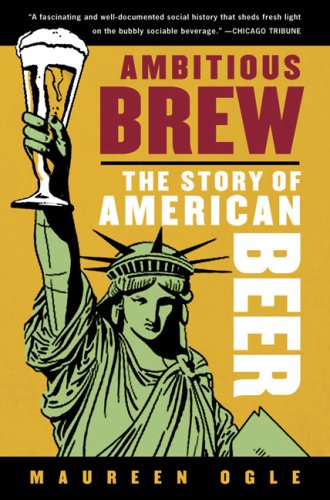I wonder if BMC came first, and then people decided they desired it (based on price and marketing, and eventually self-imposed, self-taught "preference"), or if people's desire for BMC came first, and then the BMC itself. (I would say the first is truer.)
Honestly, I think those beers are entirely a construct of cheap corn, industrial automation, and shareholder driven profiteering. Removing the first two, and probably the third as well, I have a hard time imagining they drank anything like it 500 years ago. They are notoriously hard to clone right? I would imagine they would have been unlikely to spend so much time and labor trying to create something that tasted so much like pilsner + urine.
Actually Maureen Ogle in her book
Ambitious Brew: The Story of America Beer cleared up a lot of those "beer myths" that we beer snobs used to harbor to "keep us warm" and to somehow make us think that we're better than those who drink Bud products.....
It covers everything from the migration of the Buschs, the Miller's, etc fro Germany until the 80's THEN it goes into a good deal about the history of CRAFT BREWING...so it's a pretty good into to beer history and culture as a whole.
Maybe you should learn a little of the truth, instead of just bud bashing, that old song and dance.
America like most of the world had quite an extensive array of beers available prior to the German Invasion of brewer's which
later introduced the light lager. They pretty much had the "brewing culture" of all the countries that people immigrated from...Most English beer styles..you know Porters, Stouts, Partigyles, stuff like that. As well as mostly heavy German Styles of beer. Not to mention people from Scotland, Ireland, Russia and other places where beer was drank.
Remember up until then,
beer was food.
But in the prosperous new world,
people could actually eat meat with nearly every meal if they wanted, so their dietary needs change. They didn't WANT filling beers anymore.
Beer sales started to slip....
In fact the whole history of the light lager is the American populace's (not the brewer's) desire to have a lighter beer to drink, which forced the German brewers to look at adding adjuncts like corn and rice...not as the popular homebrewer's myth has been to make money by peddling and "inferior commercial product" by adding adjuncts, but in order to come up with a style of beer that the American people wanted.
Not the other way around.
Maureen Ogle proved that it actually made the cost of a bottle of Budweiser cost around 17.00/bottle in today's dollars.
When AH released Budweiser with it's corn and rice adjuncts in the 1860's it was the most expensive beer out there; a single bottle retailed for $1.00 (what would equal in today's Dollars for $17.00) this was quite difference when a schooner of beer usually cost a nickel.
The American populace ate it up!
It wasn't done to save money, it was done because heavy beers (both english style Ales and the heavier Bavarian malty beers) were not being drunk by American consumers any more. Beer initally was seen around the world as food (some even called it liquid bread), but since America, even in the 1800's was a prosperous nation compared to the rest of the world, and americans ate meat with nearly every meal, heavy beers had fallen out of favor...
And American Barley just made for heavy, hazy beer
Bush and other German Brewers started looking at other styles of Beers, and came upon Karl Balling and Anton Schwartz's work at the Prague Polytechnic Institute with the Brewers in Bohemia who when faced with a grain shortage started using adjuncts, which produced the pils which was light, sparkly and fruity tasting...just the thing for American tastebuds.
So the brewers brought Schwartz to America where he went to work for American Brewer Magazine writing articles and technical monographs, teaching American brewers how to use Rice and Corn...
The sad moral of the story is....The big evil corporate brewers did NOT foist tasteless adjunct laced fizzy water on us, like the popular mythology all of us beersnobs like to take to bed with us to feel all warm and elitist....it was done because our American ancestors wanted it.
Listen to this from Basic Brewing;
November 30, 2006 - Ambitious Brew Part One
We learn about the history of beer in the USA from Maureen Ogle, author of "Ambitious Brew - The Story of American Beer." Part one takes us from the Pilgrims to Prohibition.
http://media.libsyn.com/media/basicbrewing/bbr11-30-06.mp3
December 7, 2006 - Ambitious Brew Part Two
We continue our discussion about the history of beer in the USA with Maureen Ogle, author of "Ambitious Brew - The Story of American Beer." Part two takes us from Prohibition to the present day.
http://media.libsyn.com/media/basicbrewing/bbr12-07-06.mp3
The truth is a little different than the snobby lie that make us feel more "elite" than the masses, eh?

It's alway easier to swallow a good delusion than to accept a painful truth. For example I constantly tell myself that those "19 year old bisexual strippers" that send me messages on myspace actually did read my profile and really do think my 45 year old sorry ass is "hawt." I never write back, (I wouldn't want to deprive them of their fantasies) but simply bask in the glory of my uber-studliness...It keeps me warm at night while I sleep in my bed...alone.






